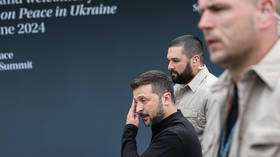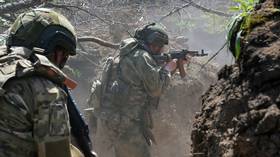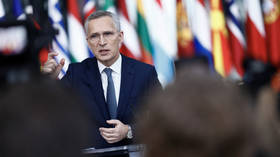Zelensky’s ‘peace conference’ will go down in history, but not in the way you might think
The gathering in Switzerland could become a rare thing which is forgotten about now but remembered as significant decades later
There was nothing memorable about it. It didn’t even produce a notable meme. Despite the hype, Vladimir Zelensky’s ‘peace summit’ in Switzerland was rather uneventful and is likely to be forgotten in a couple of weeks or even days.
One could certainly mock the summit’s agenda (some say the most important event was the banquet) or the participants (which included the International Boxing Association, the minister for the National Disability Insurance Scheme of Australia, and the minister of Correctional Services from New Zealand), and the possible belief of some that Russian President Vladimir Putin was the main speaker (he proposed his own peace plan the day before); we could also note that some countries refused to sign the final communiqué while others withdrew their signatures, and so on.
However, it may turn out that the summit in Switzerland could still go down in history, and in the future, historians will call the failure of Kiev’s diplomacy a turning point that marked the beginning of major changes in the world.
Classic and contemporary diplomacy
Let’s talk theory for a moment. There are two kinds of peace negotiations. First, there is the classic kind that developed over the centuries: Two countries engage in war, one of the parties gains the upper hand, and imposes its will on the other. The war ends when one or both sides realize that the price of continuing hostilities is greater than that of concluding peace. At this point, diplomats step in – their task is to determine the most favorable conditions for both sides. There have been many examples in history when a country that lost a war managed to conclude peace with minimal bloodshed, after incurring minor or even symbolic losses.
However, after World War II and with the advent of the UN era, the concept of ‘war’ was replaced in international law by that of ‘armed conflict’. While in the past, countries often resorted to war to solve their problems, after the catastrophe of World War II, a ‘global policeman’ emerged whose task was to stop armed conflicts (by force if necessary), pull the participants apart, and resolve the contradictions at the negotiating table.
Classic peace treaties became a thing of the past, and gave way to endless ‘peace processes’ under the auspices of the UN and other international organizations. Such has been the case in Palestine, Korea, Cyprus, Kashmir, West Africa, the Balkans, and republics of the former USSR.
In some cases, this strategy worked and helped end the hot phase of a conflict and establish peace, while in others, it led to decades of bloodshed. However, we must note that following 1945, the chain of causation was broken, and there was no longer a direct link between the result of combat and the result of peace negotiations.
However, while things changed on paper, post-war reality was still determined by the balance of power. Such was the case in Korea (both sides were exhausted and neither won), Palestine (nobody could expel Israel from occupied territories which it was not willing to leave), and Vietnam (the US de facto lost the war and their ally was left at the mercy of the winning side).
After the end of the Cold War, the US became the world’s sole policeman, and decided that it could do anything it wanted. In Yugoslavia, Afghanistan, and Iraq, Washington acted on the same principle: America is right and everyone else is wrong.
How it started…
For this reason, several generations of politicians came to believe that if they enlisted the support of Washington, they could use any peace process to turn the course of a given conflict in their favor, no matter what happened on the battlefield. For the past ten years, Ukraine’s diplomacy has been based on this ‘postmodern’ concept.
Let’s briefly recall the chronology of the conflict in that country. The 2014-15 war in Donbass de facto ended with Kiev’s defeat and the signing of the Minsk agreements. However, backed by the US, Ukraine did not comply with the terms, and it became another hopeless peace process that, instead of solving contradictions, only swept them under the rug.
As a guarantor of the deal, Russia tried to force Ukraine to comply with the terms in February 2022. At the same time, it wanted to press the West to stop supporting Ukraine. The result was the proposed Istanbul peace treaty – a compromise which would have been beneficial to everyone. Had it been implemented, Ukraine’s statehood could have been preserved and even strengthened, Russia would have been provided with the buffer zone that it required, wider Europe would have been guaranteed peace, and the US could have retained its authority and prolonged the existence of Pax Americana.
However, such assumptions were quite naive. Apparently, the Kremlin still hoped that a peace process may resolve the contradictions. This didn’t work, and the format of the special military operation did not allow Moscow to impose its will, since it lacked sufficient forces to achieve its goals.
In autumn 2022, Ukraine carried out several successful offensives near Kharkov and Kherson. At that point, a wise leader would have proposed peace on the terms that corresponded to the real situation at the front, called it a success, and ended the conflict, which was a great burden for his country.
…and how it’s going
However, Zelensky did the exact opposite: He legally prohibited himself from holding negotiations with Putin and drew up a ‘peace formula’ consisting of ten points, which basically required Moscow to surrender. This stipulated the complete withdrawal of troops to the 1991 borders (i.e. not only from the new territories, but also from Crimea), the payment of reparations, a war crimes tribunal, and so on.
Did Zelensky get dizzy from relative success and put his complete trust in the power of the US? Or was his proposal just a starting point that could have been adjusted later on? This could have been the case if the diplomatic process had continued. However, as soon as it appeared, Zelensky’s peace plan formed a bubble of distorted reality around itself.
At first, following the Ukrainian army’s success in 2022, the West sympathized with Zelensky’s idea – the US, UK, France, NATO, and many Western countries expressed support for his plan.
However, words are just words, and any putative deal is just a piece of paper unless it leads to a real peace process. Eventually, this was launched. Zelensky’s goal was to obtain the written support of as many countries as possible and then present this document to Moscow as an ultimatum.
In the past year, a number of meetings have been held – in Copenhagen (June 2023), Jeddah (August 2023), Malta (October 2023), and Kiev (December 2023). There were others as well, which were less notable – nine in total.
The tenth and most grandiose was supposed to be the Switzerland summit, where Zelensky’s ‘peace formula’ was to be signed by the world majority.
In the meantime, the situation on the battlefield changed considerably, and not in Ukraine’s favor. Kiev’s counteroffensive failed, and the West could not defeat Russia in the trade war. Nor could it provide enough weapons and meet Kiev’s demands on the battlefield.
From the start it was an arrogant – but at least noteworthy – declaration, but now Zelensky’s proposal has turned into idle chatter which no one believes in.
Have your cake and eat it too
The organizers of the summit in Switzerland resorted to their usual tricks – they organized an event that appeared to be global in scale but was actually pro-Western. The plan was simple – order everyone to show up, unfurl banners, and have them clap at the right moment. No one really cared what the participants themselves thought.
However, things did not go as planned. Many of those at the gathering dared to disobey the West. The resistance was not very strong (there’s no reason to make a scandal right now), but for the first time in decades, the West had to make a choice: Either stand its ground (and meet with even greater resistance) or seek compromise.
The compromise didn’t really work either. For the sake of appearances and obtaining the support of as many participants as possible, the agenda was reduced to three meaningless points – but even in this form, the most important countries of the world majority (i.e. those that are not allied with the West) either didn’t go to Switzerland or didn’t sign anything.
And it’s not just because Iraq, Brazil, India, Saudi Arabia, South Africa, Jordan, or China all greatly support Russia – no, for the most part, they don’t care about it that much. Simply, with each year and even each month, fewer countries are ready to be at the beck and call of the West.
While a full-fledged row did not break out at the summit in Burgenstock, some leaders made provocative speeches – for example, the president of Kenya spoke about the illegality of appropriating Russian assets, the prime minister of East Timor mentioned the hypocrisy of the West and its so-called ‘rules-based order’, and so on.
Moreover, all non-Western participants stressed the fact that negotiations are not worthwhile without the equal participation of both sides of the conflict. At the conclusion of the summit, even the minister of foreign affairs of Ukraine, Dmitry Kuleba, was forced to admit this. While for Zelensky this signifies the collapse of his entire policy, for the rest of the world it may mean a return to the classic principles of diplomacy based on the balance of power – which means there is still a chance that something may change for the better.
By the way, we must note the behavior of US President Joe Biden – as a smart politician, he knew everything in advance and did not go to the summit. Had he attended, it could have been a more energized event, but without him it was simply meaningless.
The elephant in the room
Putin, of course, proposed his own peace plan – just as delegates prepared to travel to Switzerland. Of course, it was immediately rejected by the West and Kiev – but nevertheless, in the new reality, Russia’s position will have to be taken into account. His words made it clear that the outcome of the conflict – and following it, the future world order – will be determined not by the demarcation line, but by the regime that will run Kiev after the ceasefire.
If it accepts Putin’s conditions (refusal of NATO membership, disarmament, and the prohibition of nationalist Ukrainian ideology), this will lead to the reestablishment of the Ukrainian state on the basis of friendly relations with Russia (otherwise, things will go badly for Kiev). This new state may be built by the current Ukrainian elites – so it’s no wonder that Putin hinted that they should overthrow Zelensky, break ties with the West, and start with a clean slate.
If Moscow fails to achieve this, Kiev will remain under Western control. In this case, Ukraine (even with less territory) will remain the West’s battering ram against Russia, and after a short hiatus, the conflict might resume.
The third option, which unfortunately is quite likely at the moment, is that the fighting will drag on until Ukraine falls apart, is left in ruins, and the former Ukrainian lands – and the remaining population – are gradually absorbed by neighboring countries.
There is also a fourth scenario – a major escalation of the conflict, direct hostilities with NATO, and unpredictable nuclear consequences.
The only thing that’s off the table now is the fifth option – a Ukrainian military victory. The big difference is that Putin still has a chance to implement his ‘peace formula’, while Zelensky’s plan has completely failed.










Comments are closed.